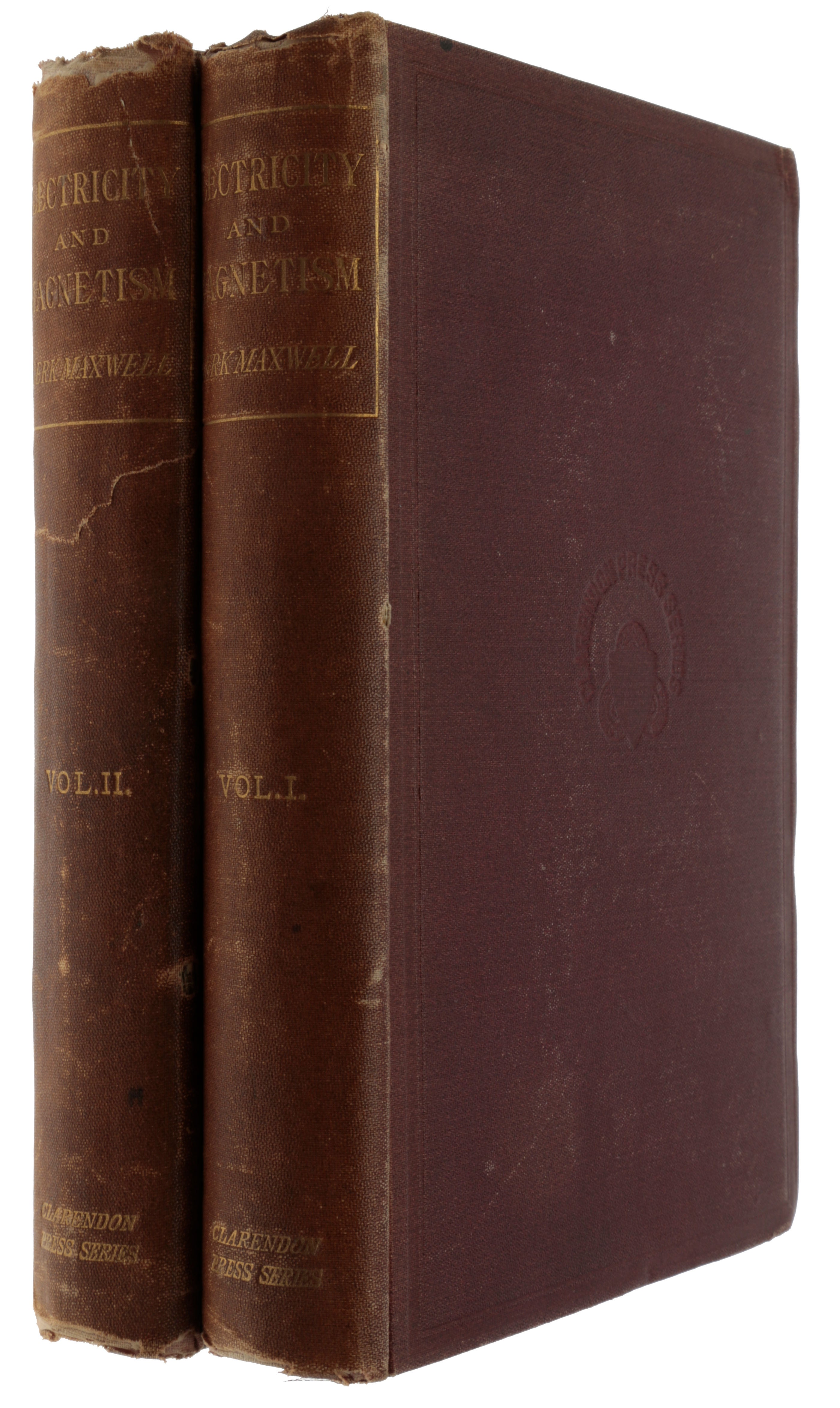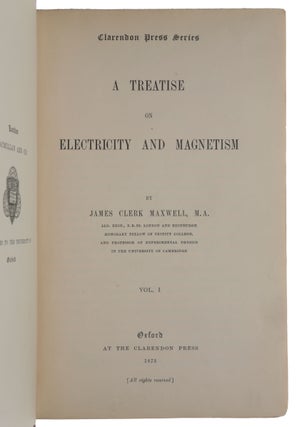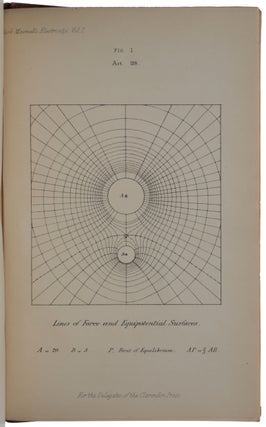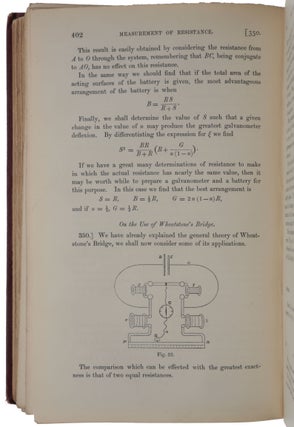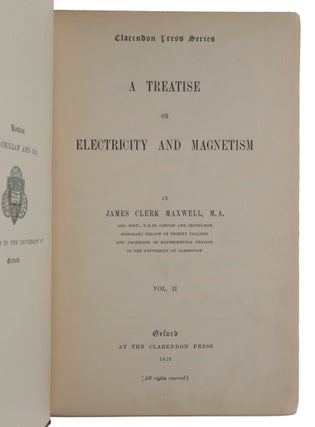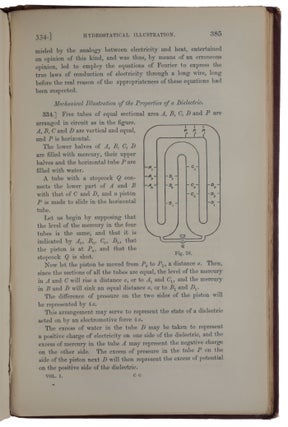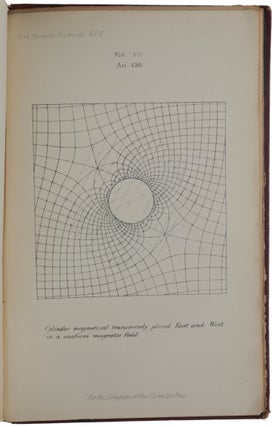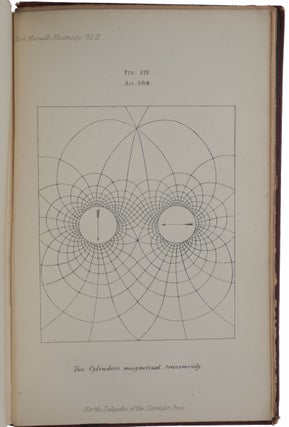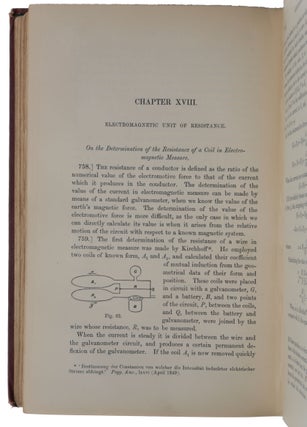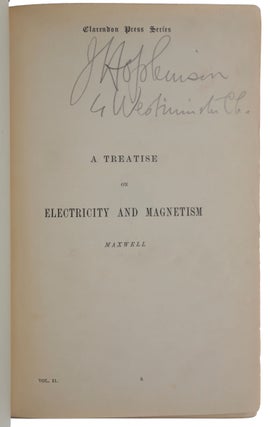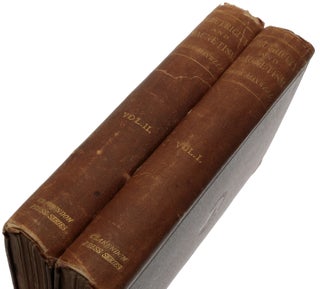A Treatise on Electricity and Magnetism.
Oxford: Clarendon Press, 1873. First edition, first issue, from the library of an important 19th century electrical engineer, of Maxwell’s presentation of his theory of electromagnetism, advancing ideas that would become essential for modern physics, including the landmark “hypothesis that light and electricity are the same in their ultimate nature” (Grolier/Horblit). “This treatise did for electromagnetism what Newton’s Principia had done from classical mechanics. It not only provided the mathematical tools for the investigation and representation of the whole electromagnetic theory, but it altered the very framework of both theoretical and experimental physics. It was this work that finally displaced action-at-a-distance physics and substituted the physics of the field” (Historical Encyclopedia of Natural and Mathematical Sciences, p. 2539). “From a long view of the history of mankind — seen from, say, ten thousand years from now — there can be little doubt that the most significant event of the 19th century will be judged as Maxwell’s discovery of the laws of electrodynamics” (R. P. Feynman, in The Feynman Lectures on Physics II (1964), p. 1-6). “[Maxwell] may well be judged the greatest theoretical physicist of the 19th century ... Einstein’s work on relativity was founded directly upon Maxwell’s electromagnetic theory; it was this that led him to equate Faraday with Galileo and Maxwell with Newton” (PMM). “Einstein summed up Maxwell’s achievement in 1931 on the occasion of the centenary of Maxwell’s birth: ‘We may say that, before Maxwell, Physical Reality, in so far as it was to represent the process of nature, was thought of as consisting in material particles, whose variations consist only in movements governed by [ordinary] differential equations. Since Maxwell’s time, Physical Reality has been thought of as represented by continuous fields, governed by partial differential equations, and not capable of any mechanical interpretation. This change in the conception of Reality is the most profound and the most fruitful that physics has experienced since the time of Newton.’ Maxwell’s achievements provided the essential bridge between the physics of Newton and of Einstein. The profound nature of this change in perception is beautifully articulated by Freeman Dyson: ‘Maxwell’s theory becomes simple and intelligible only when you give up thinking in terms of mechanical models. Instead of thinking of mechanical objects as primary and electromagnetic stresses as secondary consequences, you must think of the electromagnetic field as primary and mechanical forces as secondary. The idea that the primary constituents of the universe are fields did not come easily to the physicists of Maxwell’s generation. Fields are an abstract concept, far removed from the familiar world of things and forces. The field equations of Maxwell are partial differential equations. They cannot be expressed in simple words like Newton’s law of motion, force equals mass times acceleration. Maxwell’s theory had to wait for the next generation of physicists, Hertz and Lorentz and Einstein, to reveal its power and clarify its concepts. The next generation grew up with Maxwell’s equations and was at home in a universe built out of fields. The primacy of fields was as natural to Einstein as the primacy of mechanical structures had been to Maxwell’” (Longair). Provenance: John Hopkinson (1849-98) (inscription on half-title to vol. II, ‘J Hopkinson // 4 Westminster Ch.’). Hopkinson graduated from Cambridge as Senior Wrangler in 1871, but initially chose engineering over academia as his profession. He invented the (three-phase) system for the distribution of electrical power, was elected FRS in 1878, served as president of the IEE twice in 1890 and 1896, and in 1890 was appointed professor of electrical engineering at King’s College London, where he was also director of the Siemens Laboratory. One of his business addresses was 4 Westminster Chambers, Victoria Street, London. “Maxwell’s great paper of 1865 established his dynamical theory of the electromagnetic field. The origins of the paper lay in his earlier papers of 1856, in which he began the mathematical elaboration of Faraday’s researches into electromagnetism, and of 1861–1862, in which the displacement current was introduced. These earlier works were based upon mechanical analogies. In the paper of 1865, the focus shifts to the role of the fields themselves as a description of electromagnetic phenomena. The somewhat artificial mechanical models by which he had arrived at his field equations a few years earlier were stripped away. Maxwell’s introduction of the concept of fields to explain physical phenomena provided the essential link between the mechanical world of Newtonian physics and the theory of fields, as elaborated by Einstein and others, which lies at the heart of twentieth and twenty-first century physics” (Longair). The 1865 paper “provided a new theoretical framework for the subject, based on experiment and a few general dynamical principles, from which the propagation of electromagnetic waves through space followed without any special assumptions … In the Treatise Maxwell extended the dynamical formalism by a more thoroughgoing application of Lagrange’s equations than he had attempted in 1865. His doing so coincided with a general movement among British and European mathematicians about then toward wider use of the methods of analytical dynamics in physical problems … Using arguments extraordinarily modern in flavor about the symmetry and vector structure of the terms, he expressed the Lagrangian for an electromagnetic system in its most general form. [George] Green and others had developed similar arguments in studying the dynamics of the luminiferous ether, but the use Maxwell made of Lagrangian techniques was new to the point of being almost a new approach to physical theory—though many years were to pass before other physicists fully exploited the ground he had broken … “In 1865, and again in the Treatise, Maxwell’s next step after completing the dynamical analogy was to develop a group of eight equations describing the electromagnetic field … The principle they embody is that electromagnetic processes are transmitted by the separate and independent action of each charge (or magnetized body) on the surrounding space rather than by direct action at a distance. Formulas for the forces between moving charged bodies may indeed be derived from Maxwell’s equations, but the action is not along the line joining them and can be reconciled with dynamical principles only by taking into account the exchange of momentum with the field” (DSB). “It is significant that, while he was writing the Treatise, he was also an examiner for the Cambridge Mathematical Tripos and realized the dire need for suitable textbooks. The two-volume Treatise is, however, unlike many of the other great treatises such as Newton’s Principia in that it is not a systematic presentation of the subject but a work in progress, reflecting Maxwell’s own approach to these researches. In a later conversation, Maxwell remarked that the aim of the Treatise was not to expound his theory finally to the world, but to educate himself by presenting a view of the stage he had reached. Disconcertingly, Maxwell’s advice was to read the four parts of the Treatise in parallel rather than in sequence. “The advantage of this approach was that Maxwell laid out clearly his own perception of the physical content of the theory and also how it could be confronted by precise experiment. These topics were strongly influenced by his work for the British Association committee on fundamental standards. He devotes a large part of the Treatise to basic measurements and electrical apparatus, in the process providing many experimental challenges which would be taken up by the research students in the Cavendish Laboratory. For example, he analyses five methods of making absolute determinations of the standard of resistance, occupying the whole of ch. XVIII. “Then, on reaching section 585, halfway through Volume 2, Maxwell states that he is ‘to begin again from a new foundation without any assumption except those of the dynamical theory’. As summarized by Peter Harman, Maxwell emphasizes the expression of physical quantities free from direct representation by a mechanical model. This needed new mathematical approaches to electromagnetism, including quaternions, integral theorems such as Stokes’ theorem, topological concepts and Lagrangian–Hamiltonian methods of analytic dynamics. “One of the most important results appears in section 792 of Volume 2 in which Maxwell works out the pressure which radiation exerts on a conductor on the basis of electromagnetic theory. This profound result provides a relation between the pressure p and the energy density ε of radiation derived purely from the properties of electromagnetic fields, p = ε/3c2. This result was to be used by Boltzmann in his paper of 1884 in which he derived the Stefan–Boltzmann law from classical thermodynamics” (Longair). The Treatise “extended Maxwell’s ideas beyond the scope of his earlier work in many directions, producing a highly fecund (if somewhat confusing) demonstration of the special importance of electricity to physics as a whole. He began the investigation of moving frames of reference, which in Einstein’s hands were to revolutionize physics; gave proofs of the existence of electromagnetic waves that paved the way for Hertz’s discovery of radio waves; worked out connections between electrical and optical qualities of bodies that would lead to modern solid-state physics; and applied Tait’s quaternion formulae to the field equations, out of which Heaviside and Gibbs would develop vector analysis” (Norman). This first issue of Maxwell’s Treatise can be distinguished from the second from the eight leaves of publisher’s advertisements in the rear of volume 2; the entry for Maxwell’s Treatise itself states “just published.” James Clerk Maxwell was born in Edinburgh on 13 June 1831. His father was descended from a long line of Scottish baronets and had been trained as a lawyer. He entered the Edinburgh Academy in 1841, and the University of Edinburgh six years later, but in 1850 he left for Cambridge. There he came under the influence of George Stokes, the Lucasian Professor of Mathematics; and William Whewell, the Master of Trinity College. In 1850 he also made the acquaintance of William Thomson (later Lord Kelvin), the young Professor of Natural Philosophy at Glasgow, who certainly became a model for him. Maxwell’s was elected Fellow of Trinity College in 1855, but in the following year he became Professor of Natural Philosophy at Aberdeen. He had to resign in 1860, following changes in the university system, and in the same year he was appointed Professor of Natural Philosophy at King’s College, London. He left this position in 1865, probably in order to devote himself fully to scientific research. Over the next few years, he spent most of his time at his ancestral home Glenlair in Scotland; it was during this period that he wrote his Treatise on Electricity and Magnetism. In 1871 he was appointed to the new Chair of Experimental Physics at Cambridge and the Directorship of the Cavendish Laboratory. He occupied this position until his death on 5 November 1879. DSB IX, p.198; Grolier/Horblit 72; Norman 1666 (second issue); PMM 355; Poggendorff III, p. 889; Wheeler Gift Catalogue 1872. Achard, ‘James Clerk Maxwell, A Treatise on Electricity and Magnetism, First Edition (1873),’ Chapter 44 in Landmark Writings in Western Mathematics 1640-1940, Grattan-Guinness (ed.), 2005. Malcolm Longair, ‘. . . a paper
. . . I hold to be great guns’: a commentary on Maxwell (1865) ‘A dynamical theory of the electromagnetic field’. Philosophical Transactions A 373, No. 2039, 13 April 2015.
Two volumes, 8vo (223 x 142 mm), pp. xxix, [3], 425, [5] and 14 plates (one unnumbered plate bound between pages 148 & 149, the remainder numbered I-XIII bound at the end of the volume), with errata slip before leaf B1; xxiii, [1], 444, [2] and 7 plates (numbered XIV-XX), 15 [1] (advertisements). Original publisher’s blind-stamped plum cloth, some wear to spines, chipping to capitals, tear to spine and three small wholes to hinges on second volume, spines sunned. This first issue can be distinguished from the second from the eight leaves of publisher’s advertisements in the rear of volume 2; the entry for Maxwell’s Treatise itself states “just published.”.
Item #5293
Price: $24,500.00

